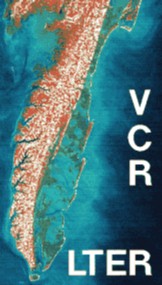 Quantitatively defining wetland hydroperiod with ecological significance to wetland functions |

Laura Stasavich and Mark Brinson
Dept. of Biology
|
 Quantitatively defining wetland hydroperiod with ecological significance to wetland functions |

Laura Stasavich and Mark Brinson
Dept. of Biology
|
The ability to quantitatively describe wetland hydroperiod in a way that captures all aspects of its dynamics would be useful in explaining how flooding dynamics relate to ecosystem functions. We define hydroperiod for tidal salt marsh sites and freshwater Myrica sites at the Virginia Coast Reserve on the Delmarva peninsula. These sites receive hydrologic inputs from three possible sources: tidal, atmospheric, and groundwater. Hydrographs for 1991 through 1996 were collected with water level recorders. Sources were separated and the relative magnitude of inputs from each of the three sources was determined based on cumulative rise in the water table. The relative magnitude of the three sources at each site was calculated for below ground and above ground rises separately. This was done on the premise that above ground flooding and below ground saturation-desaturation cycles would influence different ecosystem properties. In the extreme cases, sites range from one with nearly 100% tidal sources both above and below ground to one with nearly 100% atmospheric sources both above and below ground throughout the year. In contrast, an intermediate site had relative magnitudes for tidal, atmospheric, and groundwater above ground sources of 54%, 29%, and 9% respectively, during the summer. The below ground source was entirely from groundwater for the same period. The relative magnitudes for this particular site vary over tidal cycles and seasons. This type of information, along with cumulative frequency curves for position of the water table, further described the hydroperiod dynamics. Cumulative frequency curves can be combined with the relative contribution of the sources of flooding in order to illustrate the contribution of hydroperiod to wetland functions.